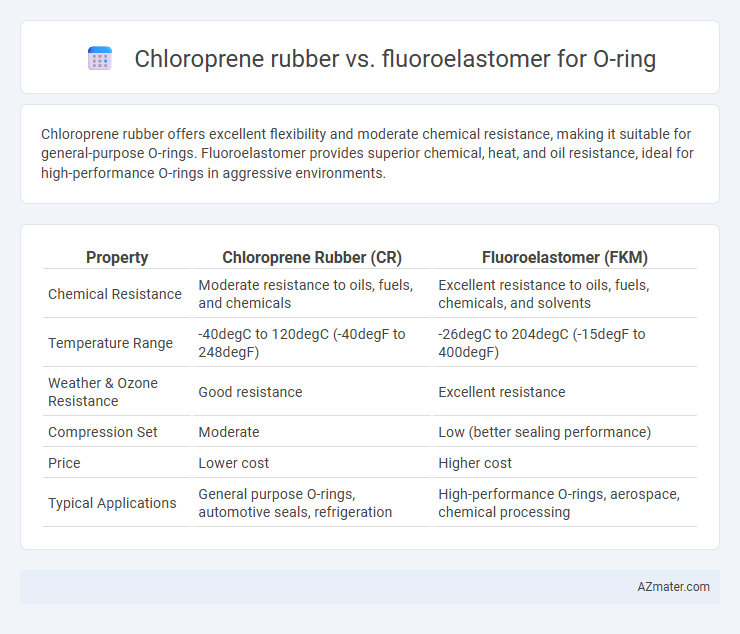Chloroprene rubber offers excellent flexibility and moderate chemical resistance, making it suitable for general-purpose O-rings. Fluoroelastomer provides superior chemical, heat, and oil resistance, ideal for high-performance O-rings in aggressive environments.
Table of Comparison
| Property | Chloroprene Rubber (CR) | Fluoroelastomer (FKM) |
|---|---|---|
| Chemical Resistance | Moderate resistance to oils, fuels, and chemicals | Excellent resistance to oils, fuels, chemicals, and solvents |
| Temperature Range | -40degC to 120degC (-40degF to 248degF) | -26degC to 204degC (-15degF to 400degF) |
| Weather & Ozone Resistance | Good resistance | Excellent resistance |
| Compression Set | Moderate | Low (better sealing performance) |
| Price | Lower cost | Higher cost |
| Typical Applications | General purpose O-rings, automotive seals, refrigeration | High-performance O-rings, aerospace, chemical processing |
Introduction to Chloroprene Rubber and Fluoroelastomer
Chloroprene rubber, also known as Neoprene, offers excellent resistance to weathering, ozone, and moderate chemicals, making it suitable for O-rings in automotive and industrial applications. Fluoroelastomer, often referred to as FKM or Viton, provides superior chemical, heat, and oil resistance, ideal for high-performance O-rings used in aerospace, chemical processing, and fuel handling. Both materials differ significantly in temperature range and chemical compatibility, influencing their selection based on specific operational environments.
Chemical Composition and Structure Comparison
Chloroprene rubber (CR) is a synthetic elastomer derived from chloroprene monomers, characterized by a polychloroprene backbone providing moderate chemical resistance and flexibility, making it suitable for general-purpose O-rings. Fluoroelastomers (FKM) consist of fluorinated monomers, which confer a highly stable carbon-fluorine bond structure that offers superior resistance to heat, fuel, oils, and aggressive chemicals in O-ring applications. The primary structural difference lies in CR's chlorinated hydrocarbon chain versus FKM's fluorinated hydrocarbon backbone, resulting in enhanced chemical inertness and thermal stability for fluoroelastomers.
Mechanical Properties of Both Materials
Chloroprene rubber O-rings exhibit excellent abrasion resistance, good tensile strength typically around 8-12 MPa, and moderate compression set, making them suitable for applications requiring durability under mechanical stress. Fluoroelastomer O-rings provide superior chemical resistance and maintain mechanical properties at high temperatures, with tensile strength ranging from 10-15 MPa and exceptional resistance to compression set, often below 20%. The choice depends on operational environment, where chloroprene offers balanced mechanical performance, while fluoroelastomer excels in harsh chemical and thermal conditions.
Temperature Resistance: Chloroprene vs Fluoroelastomer
Fluoroelastomer O-rings exhibit superior temperature resistance, typically withstanding continuous exposure from -26degC to 204degC, whereas chloroprene O-rings are limited to a narrower range of approximately -40degC to 120degC. This enhanced thermal stability makes fluoroelastomers ideal for high-temperature applications where chloroprene may degrade or lose elasticity. The chemical structure of fluoroelastomers provides resistance to heat, oils, and chemicals that can compromise chloroprene under elevated temperatures.
Chemical and Fluid Resistance Capabilities
Chloroprene rubber exhibits good resistance to moderate oils, fuels, and many chemicals, making it suitable for applications involving diluted acids, alkalis, and some solvents; however, it typically degrades when exposed to strong acids, aromatic hydrocarbons, and ketones. Fluoroelastomer (FKM) offers superior resistance to a wider range of aggressive chemicals, including fuels, oils, acids, and solvents, maintaining its integrity in high-temperature environments up to 250degC. For O-rings requiring long-term chemical and fluid resistance in harsh conditions, fluoroelastomers provide better durability and performance compared to chloroprene rubber.
Durability and Longevity in O-Ring Applications
Chloroprene rubber offers good resistance to weathering, ozone, and moderate oils, making it suitable for general-purpose O-ring applications with reliable durability. Fluoroelastomer exhibits superior chemical resistance, high-temperature stability up to 200degC, and exceptional aging characteristics, resulting in significantly longer lifespan and enhanced performance in aggressive environments. Selecting fluoroelastomer O-rings ensures extended longevity and reduced maintenance costs in harsh chemical and thermal conditions compared to chloroprene rubber.
Cost Analysis: Chloroprene Rubber vs Fluoroelastomer
Chloroprene rubber O-rings typically offer a cost-effective solution with lower material and manufacturing expenses compared to fluoroelastomer O-rings, which incur higher costs due to advanced chemical resistance and performance characteristics. Fluoroelastomers provide superior resistance to extreme temperatures, aggressive chemicals, and aging, justifying their premium price in specialized applications. Overall, selecting between chloroprene rubber and fluoroelastomer O-rings depends on balancing budget constraints with required chemical compatibility and durability.
Common Applications and Industry Usage
Chloroprene rubber O-rings are widely used in automotive, refrigeration, and industrial sealing applications due to their excellent resistance to weathering, ozone, and moderate chemicals. Fluoroelastomer O-rings are preferred in aerospace, chemical processing, and fuel systems because of their superior resistance to high temperatures, aggressive chemicals, and fuels. Both materials serve critical roles in sealing solutions, with fluoroelastomers excelling in harsh environments and chloroprene rubber being cost-effective for general-purpose use.
Environmental and Safety Considerations
Chloroprene rubber O-rings offer moderate chemical resistance but release more volatile organic compounds (VOCs) during manufacturing, posing environmental concerns. Fluoroelastomer O-rings provide superior resistance to a wide range of chemicals and extreme temperatures while generating fewer toxic emissions, enhancing safety for workers and the environment. Selecting fluoroelastomer reduces long-term environmental impact due to its durability and lower degradation products compared to chloroprene rubber.
Choosing the Right O-Ring Material: Key Takeaways
Chloroprene rubber offers excellent resistance to weathering, ozone, and moderate chemicals, making it suitable for general-purpose O-rings in automotive and industrial applications. Fluoroelastomer O-rings provide superior resistance to high temperatures, aggressive chemicals, fuels, and hydrocarbons, ideal for demanding environments such as aerospace and chemical processing. Selecting the appropriate O-ring material depends on operating temperature, chemical exposure, and mechanical stress to ensure optimal sealing performance and longevity.

Infographic: Chloroprene rubber vs Fluoroelastomer for O-ring
 azmater.com
azmater.com